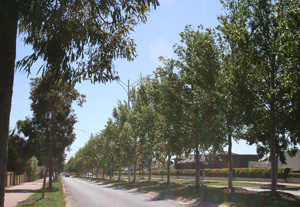 Originally estates were built for the wealthy Lords and Masters. Visionary landscapers like Capability Brown and their teams of gardeners would design and rebuild vast acreages for the "gracious living and enjoyment" of a single family. Fortunately in our egalitarian age, estates are being built and designed for the gracious living and enjoyment of communities. One of the original community estates in Europe and developed in the 1920s which has echoes in our own Sanctuary Lakes is the Wentworth Estate, with its now legendry Wentworth Golf Course and Virginia Lake. The European estates are hallmarked by their Boulevards. Although only recently established, a walk along the circuit of Sanctuary Lakes North and South Boulevards should convince the sceptical that in a very short time the Lakes Boulevards will challenge many of the famed European estates.
Originally estates were built for the wealthy Lords and Masters. Visionary landscapers like Capability Brown and their teams of gardeners would design and rebuild vast acreages for the "gracious living and enjoyment" of a single family. Fortunately in our egalitarian age, estates are being built and designed for the gracious living and enjoyment of communities. One of the original community estates in Europe and developed in the 1920s which has echoes in our own Sanctuary Lakes is the Wentworth Estate, with its now legendry Wentworth Golf Course and Virginia Lake. The European estates are hallmarked by their Boulevards. Although only recently established, a walk along the circuit of Sanctuary Lakes North and South Boulevards should convince the sceptical that in a very short time the Lakes Boulevards will challenge many of the famed European estates.
One of the keys to the visual success of the Lakes Boulevards is its simplicity. There are only four main flora elements. Two species of trees, the Simon's Poplar (Populus Simonil) a deciduous tree planted along the median strip and the Smooth-barked Apple Myrtle (Angophora Costata) on the footpaths. Two species of flowers that decorate the roundabouts and footpaths are the White Carpet Rose (Rosa noashnee) and the Iris, (Dietes grandflora).
The median strip's Simon's Poplar are also known as the Chinese Poplar, and, as the name suggests, a native of North West China. A deciduous tree with a mature height of 12 metres and a compact width of 3 to 4 metres, which makes it an ideal decorative tree for a median strip. It has a smooth, straight, whitey grey bark trunk, with leaves that range from a bright green in spring to wonderful warm yellow in autumn. Its flower is a very small (less than 30mm) catkin. The majority of the Boulevard's splendid military stance Simon's Poplar trees are edging towards maturity with probably another couple of metres to grow.
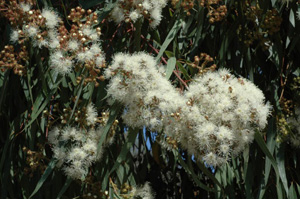 Apple Myrtle (Angophora Costata) flowers The footpath's Apple Myrtle (Angophora Costata) is also known as the Rose Gum. It differs from the majority of gum trees in the fact that although very closely related, it is not a Eucalyptus. It is a large, wide, spreading tree reaching a height of between 15 and 25 m. The trunk is often gnarled and crooked with a pink to pale grey, sometimes rusty-stained bark. The old bark is shed in spring in large flakes uncovering the new beautiful salmon-pink bark which slowly turns to a pale grey before the next shedding.
Apple Myrtle (Angophora Costata) flowers The footpath's Apple Myrtle (Angophora Costata) is also known as the Rose Gum. It differs from the majority of gum trees in the fact that although very closely related, it is not a Eucalyptus. It is a large, wide, spreading tree reaching a height of between 15 and 25 m. The trunk is often gnarled and crooked with a pink to pale grey, sometimes rusty-stained bark. The old bark is shed in spring in large flakes uncovering the new beautiful salmon-pink bark which slowly turns to a pale grey before the next shedding.
Unlike Eucalyptus, Angophora have dull-to glossy green leaves 5 to 15 cm long and 1 to 5 cm wide, which distinctively grow opposite each other along the stem. Flowering time is December to January; the small flowers are white and very showy, being produced in large bunches The individual flowers are about 2 cm wide with five tooth-like sepals, five larger semi-circular petals, and a large number of long stamens. The seed capsules are goblet shaped, 2 cm long and as wide, often with fairly prominent ribs.
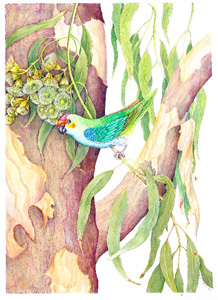 Rita Parkinson's painting of the Apple Myrtle (Angophora Costata) showing the leaf structure, bark, flowers and seed capsules with a purple crowned lorikeet checking out the neighbourhood. Apple Myrtle grows into a large and long lived tree, some having been reported to be over 150 years old. Besides looking splendid, they are great attracters of native birds, particularly the Lorikeets, Rosellas and Parrots. They not only enjoy the flowers and gums but due to the tree's habit of discarding its branches, which leave holes in the trunk, which make perfect living quarters for the birds. Already you can notice pairs around the Boulevards. Hopefully over the coming years that will increase exponentially and flocks of native birds will become a common sight.
Rita Parkinson's painting of the Apple Myrtle (Angophora Costata) showing the leaf structure, bark, flowers and seed capsules with a purple crowned lorikeet checking out the neighbourhood. Apple Myrtle grows into a large and long lived tree, some having been reported to be over 150 years old. Besides looking splendid, they are great attracters of native birds, particularly the Lorikeets, Rosellas and Parrots. They not only enjoy the flowers and gums but due to the tree's habit of discarding its branches, which leave holes in the trunk, which make perfect living quarters for the birds. Already you can notice pairs around the Boulevards. Hopefully over the coming years that will increase exponentially and flocks of native birds will become a common sight.
The Iris (Dietes Grandiflora) also known as the Fairy Iris or large Wild Iris, are a rhozomatous perennial plant with long, rigid, sword-like green leaves belonging to the Iridaceae family. Our species is a native of South Africa. The blooms are white marked with yellow and violet.
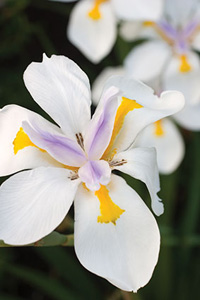 Iris (Dietes Grandiflora) flower Iris (Dietes Grandiflora) flowerThey flower in abundance during summer, especially after rain. Each flower lasts three days. The flowers attract plenty of insects, including bees and beetles, which in turn serve as food for insectivorous birds such as the Sand Martins and Swallows. After the flower's petals fall, they are followed by 5 cm long green capsules that contain very dark brown seeds, which disperse when the capsule splits open. The Wild Iris grows vigorously and in certain parts of Australia it is considered a noxious weed, but thanks to Sanctuary Lakes hard working gardeners our plants are controlled and add an informal texture to the Boulevard.
Iris (Dietes Grandiflora) flower Iris (Dietes Grandiflora) flowerThey flower in abundance during summer, especially after rain. Each flower lasts three days. The flowers attract plenty of insects, including bees and beetles, which in turn serve as food for insectivorous birds such as the Sand Martins and Swallows. After the flower's petals fall, they are followed by 5 cm long green capsules that contain very dark brown seeds, which disperse when the capsule splits open. The Wild Iris grows vigorously and in certain parts of Australia it is considered a noxious weed, but thanks to Sanctuary Lakes hard working gardeners our plants are controlled and add an informal texture to the Boulevard.
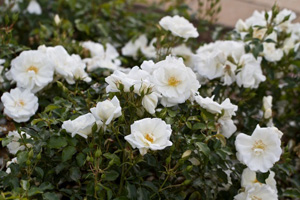 White Carpet Rose in bloom Rosa Noaschnee, also known as the White Carpet Rose is part of the Rosa genus and is a Rose variety. It grows mainly as a Perennial, which means it typically grows best over a long period (from 3 years+). The White Carpet Rose is known for its Shrub habit and growing to a height of approximately one to two metres. It has a long flowering period, producing masses of double white flowers. On the Boulevards it has been planted on the roundabouts, footpaths and as subtle screener of some of the more obtrusive road elements.
White Carpet Rose in bloom Rosa Noaschnee, also known as the White Carpet Rose is part of the Rosa genus and is a Rose variety. It grows mainly as a Perennial, which means it typically grows best over a long period (from 3 years+). The White Carpet Rose is known for its Shrub habit and growing to a height of approximately one to two metres. It has a long flowering period, producing masses of double white flowers. On the Boulevards it has been planted on the roundabouts, footpaths and as subtle screener of some of the more obtrusive road elements.
Sanctuary Lakes Head of Maintenance Greg Fryer and the brilliant team of gardeners are keeping and at times improving, the original vision of the Boulevards. Even at this early stage we are beginning to see a magnificent streetscape. It is not difficult to imagine their future growth not only with the maturing flora but with the flocks of native birds mingling through the neighbourhood. A walk around the circuit of the Boulevards will take about two hours and it guarantees to be healthy for the body and relaxing for the mind.